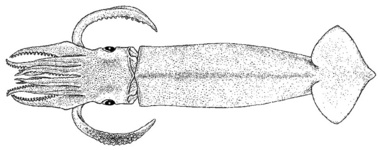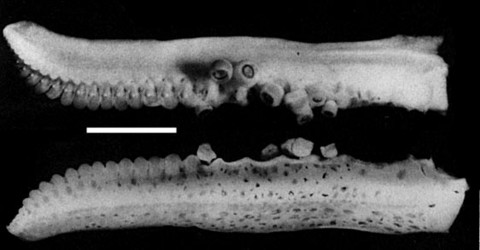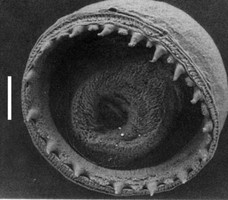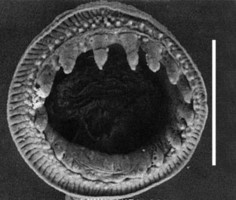Todarodes pusillus
Introduction
Todarodes pusilllus is a dwarf ommastrephid that appears to have a maximum size of less than 80 mm ML. It is generally considered to be a subspecies of T. pacificus. Distinct differences exist between the two forms and, although we have no new information, we consider them to represent separate species. Clearly molecular genetic analysis is needed to clarify their relationships especially in light of the finding by Dunning (1988) that some specimens from Hong Kong, Taiwan and the Philippines were intermediate in some characters between the Japanese form (his T. pacificus pacificus) and the Australian form (his T. pacificus pusillus).Characteristics
- Arms (Dunning, 1998)
- Right arm IV hectocotylized; hectocotylized region is 45-57% of arm length; 11-13 normal suckers present proximally; ventral trabeculae broadened and joined to form low serrated fan with about 20 pairs of trabeculae.
- Arms subequal and large; longest (arm II or III) slightly less than half ML.
- Largest arm suckers with 9-11 sharp subequal teeth on distal 2/3 of ring.
- Protective membranes of uniform height, not higher than arm suckers.
- Right arm IV hectocotylized; hectocotylized region is 45-57% of arm length; 11-13 normal suckers present proximally; ventral trabeculae broadened and joined to form low serrated fan with about 20 pairs of trabeculae.
- Tentacles
- Manus with 6-8 quadraserial sucker rows (Dunning, 1988, 1998).
- Medial manus sucker rings with 16-18 moderately large, subconical teeth interspersed with low plates; about 2.5 times marginal suckers in diameter (Dunning, 1988).
- Carpal suckers arranged as 2,2,1 (right club) or 1, 2, 1 (left club) with dentition similar to largest arm suckers; locking apparatus absent (Dunning, 1988).
- Protective membranes extend to carpal region; height never exceeds sucker height; supports weak (Dunning, 1988).
- Head (Dunning, 1988)
- Funnel component of locking-apparatus inverted T-shaped.
- Funnel groove with foveola, no side pockets.
- Fins
- Fin length 25-31% of ML (Dunning and Wormuth, 1998).
Distribution
Type locality: Timor Sea, northeast Indian Ocean at 13°48'S, 124°19'E, bottom depth 102 m.
Known distribution from off western Australia between 8°53'S (Timor Sea) and 19°31'S and from off eastern Australia between 17°16'S and 27°S. All specimens taken in bottom trawls on bottoms of 78-357 m. 54 specimens were taken in a single trawl suggesting a schooling habit. (Information from Dunning and Wormuth, 1998).
References
Dunning, M. C. 1998. Ommastrephidae. In: Carpenter, K. E., Niem, V. H. (eds.). FAO species identification guide for fishery purposes. The living marine resources of the Western Central Pacific. Vol. 2. Cephalopods, crustaceans, holothurians and sharks. FAO, Rome. p. 687-1396.
Dunning, M. C. and J. H. Wormuth. 1998. The ommastrephid squid genus Todarodes: A review of systematics, distribution, and biology (Cephalopoda: Teuthoidea). . Smithsonian Contributions to Zoology, No. 586: 385-391.
Title Illustrations

| Scientific Name | Todarodes pacificus pusillus |
|---|---|
| Reference | Dunning, M. C. 1998. Ommastrephidae. In: Carpenter, K. E., Niem, V. H. (eds.). FAO species identification guide for fishery purposes. The living marine resources of the Western Central Pacific. Vol. 2. Cephalopods, crustaceans, holothurians and sharks. FAO, Rome. p. 687-1396. |
| Creator | K. Hollis |
| View | Dorsal |
About This Page
Page copyright © 2015
All Rights Reserved.
- First online 11 October 2015
- Content changed 11 October 2015
Citing this page:
Tree of Life Web Project. 2015. Todarodes pusillus . Version 11 October 2015 (temporary). http://tolweb.org/Todarodes_pusillus/77455/2015.10.11 in The Tree of Life Web Project, http://tolweb.org/












 Go to quick links
Go to quick search
Go to navigation for this section of the ToL site
Go to detailed links for the ToL site
Go to quick links
Go to quick search
Go to navigation for this section of the ToL site
Go to detailed links for the ToL site